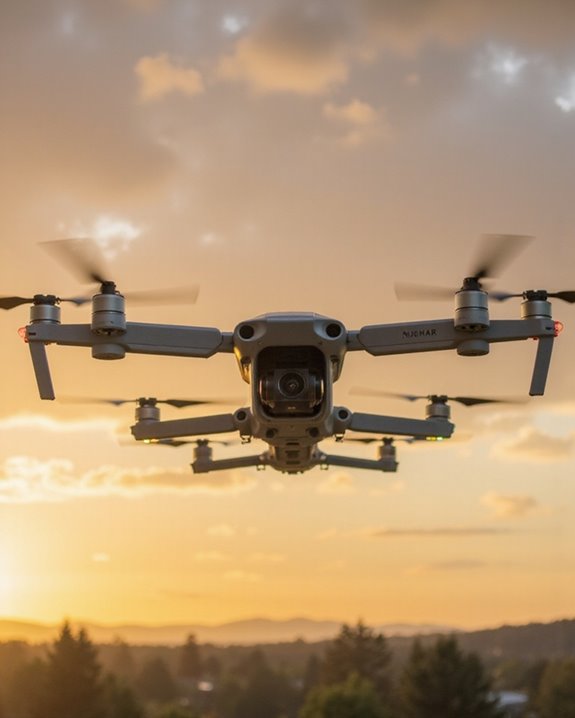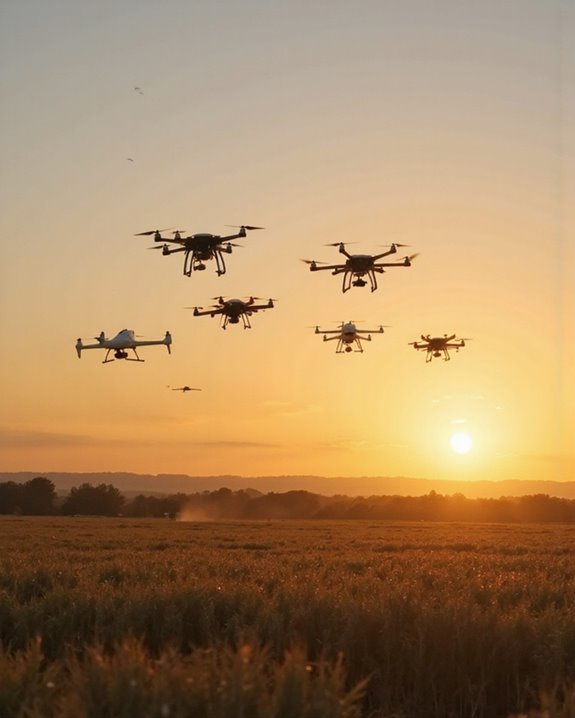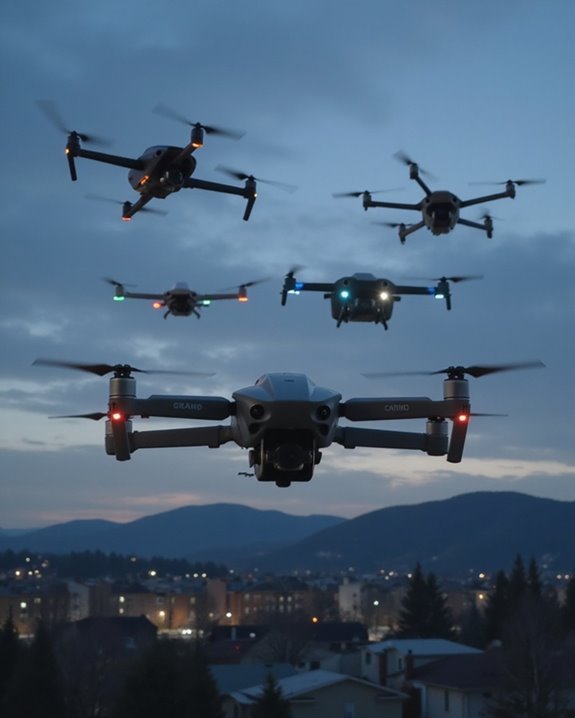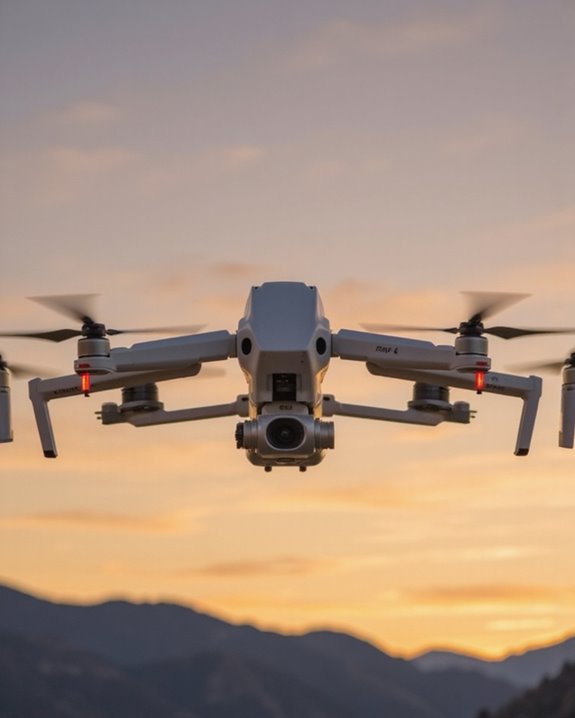Looking for the perfect M300 drone in 2025? You’ll love these top picks! The RADCLO Mini leads with a 1080P camera and impressive 22-minute flight time, while the X300C offers beginner-friendly controls. The X900 Optical Flow brings advanced stabilization, and the versatile TH4 V2 Hook transforms your DJI drone into a powerhouse. Don’t forget the 70mai SD card for capturing those epic aerial moments! Let’s explore what makes each of these drones truly soar.
Key Takeaways
- Flight time between 15-30 minutes with battery capacities of 7000-12000mAh enables extended commercial missions without frequent recharging.
- Payload capacities ranging from 2.7kg to 9kg accommodate various professional equipment while maintaining optimal flight performance.
- Advanced weather resistance with IP54-IP67 ratings and wind resistance up to 20m/s ensures reliable operation in challenging conditions.
- Camera capabilities from 1080p to 4K with wide-angle lenses (70°-120°) and CMOS sensors handle diverse professional imaging requirements.
- Smart control systems with automated features and specialized compatibility enhance operational efficiency for professional drone pilots.
Mini Drone with 1080P HD Camera and Carrying Case
- 【1080P Adjustable FPV Drone & APP Control】Equipped with a 1080P HD 90° manually adjustable lens, the drone provides a wider breathtaking field of view. It assists...
- 【Easy To Use with Stable Altitude Hold Function】: Just click the one key take-off/landing button to start flying. Compared to other drones of the same type, we have a...
- 【Larger Body Size & Full Accessories】: The package comes with a carrying case that is convenient for outdoor travel. With 2pcs 800mAh batteries, even its the body is...
Perfect for aspiring pilots and photography enthusiasts alike, the RADCLO Mini Drone packs an impressive punch in its lightweight 90-gram frame! You’ll capture stunning aerial shots with the 1080P HD camera featuring a 90° adjustable lens, while real-time FPV view lets you stream directly to your smartphone through the RADCLOFPV app.
With 22 minutes of flight time from two 800mAh batteries, you won’t have to cut your adventures short. The drone’s beginner-friendly features include one-key takeoff/landing, altitude hold, and three speed settings – plus those crowd-pleasing 360° flips that’ll have the neighbors thinking you’re a pro! The included carrying case keeps everything organized and protected for your next aerial expedition.
Best For: Beginner drone pilots and casual photographers looking for an affordable, feature-rich drone with decent flight time and basic camera capabilities.
Pros:
- Extended 22-minute flight time with two included 800mAh batteries
- Beginner-friendly features like one-key takeoff/landing and altitude hold
- Portable design at 90 grams with included carrying case for protection
Cons:
- Camera quality reported lower than advertised 1080P
- Controls can be unresponsive and prone to pairing issues
- Performance affected by wind interference when flying outdoors
X300C Mini Drone with Camera 720P HD FPV (2 Batteries)
- 【Optical Flow Positioning】The altitude hold function can keep the drone hovering at a fixed height to help you get wonderful videos and photos. In addition, the X300C...
- 【WIFI FPV Camera】 SIMREX X300C drone is equipped with a 720P HD camera to help you capture the wonderful moments in life. You can easily connect the drone to "SIMREX...
- 【Perfect for Adults and Kids】X300C mini drone offers a range of convenient and intelligent features, such as one key takeoff/landing, altitude hold, and headless mode...
The X300C Mini Drone strikes an impressive balance between capability and accessibility, making it an excellent entry point for aspiring pilots and casual photographers. You’ll love the intuitive features like one-key takeoff and landing, while the 720P HD camera lets you capture decent aerial shots through the SIMREX Zoomy app. With two batteries providing up to 18 minutes of total flight time, you’ve got plenty of opportunities to practice those epic 360° flips! While the camera quality isn’t exactly Hollywood-grade, and it might get a bit wobbly in the wind, this compact drone’s stability features and protective design make it perfect for learning the ropes without breaking the bank.
Best For: Beginner drone pilots and casual users looking for an affordable, easy-to-fly drone with basic camera capabilities and safety features for learning aerial photography.
Pros:
- User-friendly controls with one-key takeoff/landing and stable hovering features
- Compact, foldable design with protective propeller covers for safe indoor/outdoor use
- Good value with two batteries included, providing up to 18 minutes of total flight time
Cons:
- Camera quality is basic with grainy footage
- Poor performance in windy conditions
- Limited flight time per battery (6-10 minutes)
70mai 32GB Micro SD Card (100MB/s)
- 100MB/s ultra-high-speed transmission: The 70mai memory card complies with the latest UHS Video Speed Class 30 (V30) standard, providing write speeds of up to...
- Highly durable design: 70mai 32GB drop-proof and waterproof camera memory card is also heat-proof, X-ray-proof and magnet-proof. Whether in extreme weather or accidental...
- Superb performance: Class 10, UHS I, U3 speed Class performance allows for fast and smooth continuous HD shooting and full HD
Designed for reliable performance in demanding conditions, the 70mai 32GB Micro SD Card delivers impressive 100MB/s write speeds that’ll keep up with your drone’s most intense recording needs. You’ll love how this rugged card handles everything Mother Nature throws at it – from scorching heat to unexpected downpours.
The card’s Class 10 and V30 ratings guarantee smooth 4K video capture, while its durability features keep your footage safe even if your drone takes a tumble! Compatible with leading drone models and backed by stellar user ratings, this memory card’s compact 0.352-ounce frame packs serious punch without weighing down your aircraft. Talk about tiny but mighty!
Best For: Professional drone operators and action camera enthusiasts who need reliable, high-speed storage for 4K video recording in challenging environments.
Pros:
- Impressive 100MB/s write speed ensures smooth 4K video capture without dropping frames
- Comprehensive durability features protect against water, drops, heat, and magnetic interference
- Excellent compatibility across multiple devices including dash cams, drones, and action cameras
Cons:
- 32GB capacity may be limiting for longer recording sessions or high-bitrate footage
- Higher price point compared to generic micro SD cards of similar capacity
- Limited availability compared to more mainstream memory card brands
TH4 V2 Throwing Hook for DJI M300 RTK and DJI M210 V2 Drone
- EXTENDED COMPATIBILITY - Seamlessly integrates with DJI M300 RTK and M210 V2 drones via DJI SkyPort V2.0, ensuring a secure and reliable connection for diverse...
- ENHANCED FUNCTIONALITY - The CZI TH4 V2 Throwing Hook significantly expands your drone's capabilities, making it ideal for search and rescue, delivery, and inspection...
- OPTIMIZED PORTABILITY - Weighing only 10.93 oz (310g) and with compact dimensions of 3.81 x 3.07" (97 x 78mm), the TH4 V2 adds minimal bulk, preserving your drone's...
Professional cargo delivery and rescue missions demand robust equipment, which is exactly where the TH4 V2 Throwing Hook shines! With its impressive 40kg weight capacity and four specialized hooks, you’ll be ready to tackle serious aerial transportation tasks. This sleek black accessory seamlessly mounts to your DJI M300 RTK or M210 V2 drone via the SkyPort v2.0 interface.
You’re getting a compact powerhouse that measures just 2.3 x 2.3 x 4.5 inches but don’t let its size fool you – each hook can handle a 10kg single cast. Whether you’re delivering life-saving materials or transporting heavy cargo, this metal marvel’s got you covered with DJI PSDK control for precise operation.
Best For: Professional drone operators and emergency response teams who need reliable heavy-lift cargo delivery and rescue equipment compatible with DJI M300 RTK and M210 V2 drones.
Pros:
- Impressive 40kg total weight capacity with 10kg per hook for serious lifting capabilities
- Compact and durable metal construction optimized for professional use
- Seamless integration with DJI drones through SkyPort v2.0 interface and PSDK control
Cons:
- Relatively high price point for specialized equipment
- Limited compatibility with only two specific DJI drone models
- Added weight of 320g reduces overall drone flight time and performance
X900 Optical Flow Drone with 1080P HD Camera
- Phone direct control with transmission OR transmitter contorl with Smart phone. Apple IOS / Android phones compatible.
- Altitude Hold. You can release the throttle stick and the drone will keep the current height. One key take off and landing, super easy to fly & easy to shoot quality...
- Headless Security Mode. The pilot can fly the drone to any location without worrying about which diretion the drone is facing. Help bignner to prevent from losing the...
Starting out in the drone world doesn’t get more beginner-friendly than the X900 Optical Flow Drone, a compact powerhouse that’s perfect for aspiring pilots and recreational enthusiasts. You’ll love its foldable design that packs down to just 130×90×45mm, making it incredibly portable for all your adventures.
With three speed modes and a solid 12-15 minute flight time, you’re getting impressive bang for your buck! The 1080P HD camera captures crisp footage through its 110-degree wide-angle lens, while features like altitude hold and headless mode help you master the basics. Don’t worry about those first-time jitters – the one-key takeoff and landing controls have got your back.
Best For: Entry-level drone enthusiasts and beginners looking for an affordable, feature-rich quadcopter with good safety features and easy controls.
Pros:
- Compact foldable design makes it highly portable and easy to transport
- Multiple beginner-friendly features including one-key takeoff/landing and headless mode
- Good quality 1080P HD camera with wide-angle lens for aerial photography
Cons:
- Limited range of 80-120 meters compared to more advanced drones
- Relatively short flight time of 12-15 minutes per battery charge
- Basic plastic construction may affect durability in crashes or strong winds
Factors to Consider When Choosing an M300 Drone

Choosing the perfect M300 drone requires careful consideration of several key factors that’ll make or break your flying experience! You’ll want to examine vital aspects like flight duration and operational range, camera specs and imaging capabilities, payload capacity for your specific needs, and how well it handles challenging weather conditions. Before making your final decision, don’t forget to check if the drone’s control system works seamlessly with your existing equipment – trust me, there’s nothing worse than discovering compatibility issues after you’ve already made the purchase.
Flight Time and Range
Performance in the air comes down to two critical factors that can make or break your drone operations: flight time and range. You’ll want to carefully consider how long your M300 can stay airborne on a single charge, which typically spans from 15 to 30 minutes depending on your payload and flying conditions.
When it comes to range, you’re looking at coverage from several hundred meters to multiple kilometers – and trust me, you don’t want to lose signal mid-mission! The sweet spot is finding a balance between these two features, as they’re like distant cousins who don’t always get along. Remember, longer flight times mean you can tackle those big mapping projects without constant battery swaps, while extended range lets you explore further (just don’t get too adventurous and lose sight of your drone!).
Camera and Imaging Quality
A drone’s camera and imaging capabilities serve as its eyes in the sky, making this feature absolutely essential for professional operators! You’ll want to pay close attention to resolution options – there’s a world of difference between standard 1080p and crystal-clear 4K footage when you’re capturing those million-dollar aerial shots.
The sensor technology is your best friend in tricky lighting conditions, so look for advanced CMOS sensors that’ll handle everything from bright sunlight to dusky horizons. You’ll also need to evaluate the field of view – anywhere from 70° to 120° – because sometimes you need the big picture, and other times you’re zeroing in on the details! Don’t forget about stabilization features and file formats – they’re the unsung heroes that’ll make your post-processing life much easier.
Load Carrying Capacity
The mighty load carrying capacity of your M300 drone can make or break its performance in the field! When you’re choosing an M300, you’ll want to carefully evaluate how much weight it can safely transport during missions.
Today’s top M300 models boast impressive payload capacities ranging from 2.7 kg to a whopping 9 kg, giving you plenty of flexibility for different applications. You’ll need to evaluate what you’re planning to attach – whether it’s high-end sensors, delivery packages, or specialized equipment. Remember, while a higher capacity sounds great, it’ll impact your flight time and power consumption! The sweet spot is finding a drone that can handle your required payload while maintaining ideal performance. Don’t be that person who overloads their drone and watches it struggle like a tired honey bee!
Weather Resistance Features
Selecting an M300 drone with robust weather resistance features can mean the difference between completing your mission or watching your investment plummet from the sky! You’ll want to prioritize models with strong IP ratings – an IP54 rating is good, but IP67 is even better for those unexpected downpours.
Look for drones that can handle temperature extremes from -10°C to 40°C, because nobody wants their expensive tech turning into a frozen paperweight! The best M300s offer wind resistance up to 20 meters per second, and they’re equipped with sealed electronics that laugh in the face of humidity. For next-level protection, you’ll love the smart weather detection systems that automatically adjust flight parameters – they’re like having a tiny meteorologist built right into your drone. Talk about playing it safe in style!
Control System Compatibility
When it comes to control system compatibility, you’ll want to make sure your M300 drone plays nicely with all your existing gear! Look for control systems that support multiple remote interfaces – you don’t want to be stuck with a one-trick pony when it comes to operating your high-tech flying friend.
Your drone should seamlessly connect with standard software development kits (SDKs), giving you the freedom to program custom features that’ll make other pilots jealous. Check that it’s compatible with common wireless protocols, and guarantee it’ll pair smoothly with your smartphone or laptop for real-time monitoring. Don’t forget about those mounting interfaces – they’re essential for attaching various payloads and accessories. After all, what good is a drone that won’t connect with your favorite tools? Remember, flexibility is key in today’s fast-evolving drone tech landscape!
Battery Performance Specs
Power-hungry pilots, you’ll want to pay close attention to battery performance specs when choosing your M300 drone! Your flight time sweet spot depends on finding the right balance of capacity, voltage, and discharge rates.
Look for batteries with capacities between 7000-12000mAh if you’re aiming for those epic 45-minute flights. You’ll need voltage levels between 7.4V and 22.8V, with higher voltages giving you more zip when you need it. Don’t forget about those C-ratings – aim for at least 25C to handle those demanding aerial maneuvers without breaking a sweat! While charging times of 1-3 hours might test your patience (perfect coffee break timing!), the wait is worth it for consistent performance. Remember, battery specs aren’t just numbers – they’re your ticket to longer, stronger flights!
Safety and Navigation Systems
Now that you’ve got your power needs sorted, let’s focus on keeping your M300 safe and steady in the skies! The smart altitude hold system is your best friend here, using advanced sensors to maintain rock-solid height control – no more unexpected dips or dives when you’re capturing that perfect shot!
You’ll want to look for models with emergency stop features (because sometimes things don’t go as planned!) and precise optical flow positioning that tracks ground features like a hawk. Don’t forget about those vital low battery warnings – they’ll give you plenty of time to bring your drone home safely when power starts running low. The headless orientation mode is a game-changer too, making navigation feel natural even when your drone’s facing a different direction than you are.
Maintenance and Durability
Built like a tank but requiring a gentle touch, your M300’s durability hinges on smart maintenance choices! You’ll want to inspect and clean those components after every flight – it’s like giving your drone a mini spa day that’ll add years to its life.
Regular maintenance isn’t just about keeping things shiny; it’s about protecting your investment. Those high-impact materials can handle quite a beating, but they’ll perform 40% better when you’re diligent about upkeep. Keep an eye on your battery’s health (those 300-500 charge cycles go by faster than you’d think!), and don’t forget to replace those hardworking propellers every 50-100 flight hours. Think of it as changing your drone’s running shoes – they need fresh treads to keep performing at their best!
Frequently Asked Questions
How Long Does It Typically Take to Become Proficient at Flying M300 Drones?
Picture yourself gracefully maneuvering your M300 through sun-dappled skies – you’ll get there! Most pilots achieve basic proficiency within 15-20 hours of hands-on flight time. You’ll master essential controls and basic maneuvers in your first 5-10 hours, while advanced skills like precise camera work and complex flight patterns take another 10-15 hours. Don’t rush it though – every flight builds your confidence and expertise. Practice makes perfect!
Can M300 Drones Be Used in Professional Filmmaking and Cinematography Projects?
Yes, you can absolutely use M300 drones for professional filmmaking! The drone’s stable flight performance, 4K camera capabilities, and precision controls make it perfect for capturing cinematic aerial shots. You’ll love its dual operator mode, where one person can pilot while another controls the camera. Many production companies use M300s for everything from commercials to documentaries, thanks to their reliable performance and high-quality imagery in various lighting conditions.
What Weather Conditions Are Considered Safe for M300 Drone Operations?
You’ll be happy to know that M300 drones are quite weather-resistant! You can safely operate them in temperatures ranging from -4°F to 122°F (-20°C to 50°C). They can handle winds up to 33 mph and light rain, but you’ll want to avoid heavy precipitation and thunderstorms. For the best flying experience, stick to conditions with good visibility and less than 15 mph winds – your footage will thank you later!
Are There Special Licenses Required for Commercial Use of M300 Drones?
Like getting your driver’s license, you’ll need proper certification before taking your M300 to the skies! You’ll need to obtain your Part 107 Remote Pilot Certificate from the FAA, which includes passing a knowledge test. For commercial operations, you’ll also want liability insurance, and depending on your specific use case, you might need additional waivers for operations like flying at night or over people. Don’t forget your state’s requirements too!
How Often Should Maintenance and Firmware Updates Be Performed on M300 Drones?
You’ll want to perform basic maintenance checks on your M300 before every flight – it’s like giving your drone a quick health checkup! For more thorough inspections, schedule them every 50 flight hours or 6 months, whichever comes first. As for firmware updates, you should check DJI’s website monthly for new releases and install them promptly to maintain best performance and safety features. Don’t skip these updates – they’re essential for keeping your drone running smoothly!










